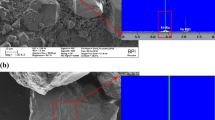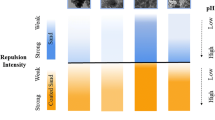Abstract
Sulfolane is an emerging contaminant, miscible in pure water. The correlation between mixing behavior and transport of sulfolane with sulfate and chloride salts is not fully understood. Sulfate salts (e.g., Na2SO4) decrease the solubility of sulfolane in water. Specifically, solutions with 30wt% sulfolane separated into bulk phases with 130 g/kg Na2SO4 (2.4 mol% Na2SO4 relative to the total mixture) and emulsions formed with lower concentrations of Na2SO4 (41 g/kg or 0.7 mol% Na2SO4 relative to the total mixture). This is not observed with chlorides at these same concentrations. Na2SO4 enhanced sulfolane sorption onto montmorillonite clay, with 0.2 g sulfolane sorbed/g clay at high Na2SO4 concentrations (40.7 g Na2SO4/kg solution). As a result, Na2SO4 delayed sulfolane migration in model clayey fractures, compared to pure water. Sulfolane and co-contaminants such as toluene reciprocally influence their miscibility in water. Sulfolane emulsified toluene in pure water, while Na2SO4 supressed emulsification. In turn, sulfolane partitioned in toluene, and Na2SO4 enhanced this behavior by decreasing sulfolane miscibility in water. In flow tests conducted with 0.7 mol% Na2SO4 and 30wt% sulfolane (relative to water), the sulfolane concentration at the outlet is lower than that at the inlet for up to 80% of the total eluted volume. Therefore, in model sandy aquifers, the vertical migration of sulfolane was delayed with Na2SO4 and toluene, which floated on water and was trapped in soil pores due to capillary forces. Chloride salts had a less significant effect on toluene solubility in water and on its migration through model porous media.
Graphical Abstract










Similar content being viewed by others
Data availability
The data will be made available upon reasonable request to the authors.
References
Bartokova, B., Marangoni, A. G., Laredo, T., & Pensini, E. (2023a). Phase behavior of sulfolane: Potential implications for transport in groundwater. Colloids and Surfaces A, 677, 132451.
Bartokova, B., Marangoni, A. G., Laredo, T., & Pensini, E. (2023b). Role of Hydrogen Bonding on Solvent Separation Using Amphiphilic Sorbitan Ester. Colloids and Surfaces C, 1, 100004.
Chang, S. H., Wu, C. F., Yang, C. F., & Lin, C. W. (2021). Evaluation use of bioaugmentation and biostimulation to improve degradation of sulfolane in artificial groundwater. Chemosphere, 263, 127919.
Chang, S. H., Lin, C. W., Cheng, Y. S., & Liu, S. H. (2023). Effects of biodegradation, biotoxicity and microbial community on biostimulation of sulfolane. Chemosphere, 319, 138047.
Darko, E., & Thurbide, K. B. (2022). Sulfolane as a novel stationary phase for analytical separations by gas chromatography. Analytica Chimica Acta, 1189, 339254.
Dinh, M., Hakimabadi, S. G., & Pham, A. L. T. (2020). Treatment of sulfolane in groundwater: A critical review. Journal of Environmental Management, 263, 110385.
Doucette, W. J., Chard, J. K., Moore, B. J., Staudt, W. J., & Headley, J. V. (2005). Uptake of sulfolane and diisopropanolamine (DIPA) by cattails (Typha latifolia). Microchemical Journal, 81, 41–49.
Earnden, L., Marangoni, A. G., Gregori, S., Paschos, A., & Pensini, E. (2021). Zein-bonded graphene and biosurfactants enable the electrokinetic clean-up of hydrocarbons. Langmuir, 37, 11153–11169.
Earnden, L., Marangoni, A. G., Laredo, T., Stobbs, J., & Pensini, E. (2022a). Self-Assembled glycerol monooleate demixes miscible liquids through selective hydrogen bonding to water. Journal of Molecular Liquids, 367, 120551.
Earnden, L., Marangoni, A. G., Laredo, T., Stobbs, J., & Pensini, E. (2022b). Mechanisms of separation between tetrahydrofuran and water using hydroxystearic acid. Physics of Fluids, 34, 097119.
Gleick, P. H., & Cooley, H. (2021). Freshwater scarcity. Annual Review of Environment and Resources, 46, 319–348.
Gorelick, S. M., & Zheng, C. (2015). Global change and the groundwater management challenge. Water Resources Research, 51, 3031–3051.
Gue, A. E., Mayer, B., & Grasby, S. E. (2015). Origin and geochemistry of saline spring waters in the Athabasca oil sands region, Alberta, Canada. Applied Geochemistry, 61, 132–145.
Guo, L., & Lee, H. K. (2011). Low-density solvent-based solvent demulsification dispersive liquid–liquid microextraction for the fast determination of trace levels of sixteen priority polycyclic aromatic hydrocarbons in environmental water samples. Journal of Chromatography A, 1218, 5040–5046.
Hendry, M. J., Cherry, J. A., & Wallick, E. I. (1986). Origin and distribution of sulfate in a fractured till in southern Alberta, Canada. Water Resources Research, 22, 45–61.
Izadifard, M., Achari, G., & Langford, C. H. (2018). Mineralization of sulfolane in aqueous solutions by Ozone/CaO2 and Ozone/CaO with potential for field application. Chemosphere, 197, 535–540.
Jeon, J., Kannan, K., Lim, B. J., An, K. G., & Kim, S. D. (2011). Effects of salinity and organic matter on the partitioning of perfluoroalkyl acid (PFAs) to clay particles. Journal of Environmental Monitoring, 13(6), 1803–1810.
Jeong, S. W., & Corapcioglu, M. Y. (2005). Force analysis and visualization of NAPL removal during surfactant-related floods in a porous medium. Journal of Hazardous Materials, 126, 8–13.
Jung, K., Ok, Y. S., & Chang, S. X. (2011). Sulfate adsorption properties of acid-sensitive soils in the Athabasca oil sands region in Alberta, Canada. Chemosphere, 84, 457–463.
Kasanke, C. P., & Leigh, M. B. (2017). Factors limiting sulfolane biodegradation in contaminated subarctic aquifer substrate. PLoS ONE, 12, e0181462.
Khan, M. F., Yu, L., & Achari, G. (2020). Field evaluation of a pressurized ozone treatment system to degrade sulfolane in contaminated groundwaters. Journal of Environmental Chemical Engineering, 8, 104037.
Kim, C. G., Clarke, W. P., & Lockington, D. (2000). Determination of retardation coefficients of sulfolane and thiolane on soils by Kow-Koc and solubility parameter, batch and column experiments. Environmental Geology, 39, 741–749.
Lamont, K., Marangoni, A., & Pensini, E. (2020). ‘Emulsion locks’ for the containment of hydrocarbons during surfactant flushing. Journal of Environmental Sciences, 90, 98–109
Li, P., Karunanidhi, D., Subramani, T., & Srinivasamoorthy, K. (2021a). Sources and consequences of groundwater contamination. Archives of Environmental Contamination and Toxicology, 80, 1–10.
Li, M., Zhuang, B., Lu, Y., An, L., & Wang, Z. G. (2021b). Salt-induced liquid–liquid phase separation: Combined experimental and theoretical investigation of water–acetonitrile–salt mixtures. Journal of the American Chemical Society, 143, 773–784.
Lin, W. C., Tsai, T. H., Lin, T. Y., & Yang, C. H. (2008). Influence of the temperature on the liquid–liquid equilibria of heptane+ toluene+ sulfolane and heptane+ m-xylene+ sulfolane. Journal of Chemical & Engineering Data, 53, 760–764.
Lin, C. W., Liu, S. H., Wu, C. F., & Chang, S. H. (2021). Critical factors for enhancing the bioremediation of a toxic pollutant at high concentrations in groundwater: Toxicity evaluation, degrader tolerance, and microbial community. Journal of Environmental Management, 277, 111487.
Lu, J., Wu, L., & Letey, J. (2002). Effects of soil and water properties on anionic polyacrylamide sorption. Soil Science Society of America Journal, 66, 578–584.
Luther, S. M., Dudas, M. J., & Fedorak, P. M. (1998). Sorption of sulfolane and diisopropanolamine by soils, clays and aquifer materials. Journal of Contaminant Hydrology, 32, 159–176.
Marshall, T., Gravelle, A., Marangoni, A. G., Elsayed, A., & Pensini, E. (2020). Zein for hydrocarbon remediation: Emulsifier, trapping agent, or both? Colloids and Surfaces A, 589, 124456.
Marshall, T., Earnden, L., Marangoni, A. G., Laredo, T., & Pensini, E. (2022a). Cubic mesophases of self-assembled amphiphiles separate miscible solvents. Colloids and Surfaces A, 650, 129548.
Marshall, T., Marangoni, A. G., Laredo, T., Al-Abdul-Wahid, M. S., & Pensini, E. (2022b). Mechanisms of solvent separation using sugars and sugar alcohols. Colloids and Surfaces A, 642, 128707.
Médout-Marère, V. (2000). A simple experimental way of measuring the Hamaker constant A11 of divided solids by immersion calorimetry in apolar liquids. Journal of Colloid and Interface Science, 228, 434–437.
Mohsen-Nia, M., & Paikar, I. (2007). (Liquid+ liquid) equilibria of ternary and quaternary systems containing n-hexane, toluene, m-xylene, propanol, sulfolane, and water at T= 303.15 K. The Journal of Chemical Thermodynamics, 39, 1085–1089.
Pecini, E. M., & Avena, M. J. (2013). Measuring the isoelectric point of the edges of clay mineral particles: The case of montmorillonite. Langmuir, 29, 14926–14934.
Pensini, E., Yip, C. M., O’Carroll, D. M., & Sleep, B. E. (2012a). effect of water chemistry and aging on iron- mica interaction forces: Implications for iron particle transport. Langmuir, 28, 10453–10463.
Pensini, E., Sleep, B. E., Yip, C. M., & O’Carroll, D. (2012b). Forces of interactions between bare and polymer-coated iron and silica: Effect of pH, ionic strength, and humic acids. Environmental Science & Technology, 46, 13401–13408.
Pensini, E., Sleep, B. E., Yip, C. M., & O’Carroll, D. (2013). Forces of interactions between iron and aluminum silicates: Effect of water chemistry and polymer coatings. Journal of Colloid and Interface Science, 411, 8–15.
Pensini, E., Tchoukov, P., Yang, F., & Xu, Z. (2018). Effect of humic acids on bitumen films at the oil-water interface and on emulsion stability: Potential implications for groundwater remediation. Colloids and Surfaces A, 544, 53–59.
Stüber, F., Font, J., Eftaxias, A., Paradowska, M., Suarez, M. E., Fortuny, A., Bengoa, C., & Fabregat, A. (2005). Chemical wet oxidation for the abatement of refractory non-biodegradable organic wastewater pollutants. Process Safety and Environmental Protection, 83, 371–380.
Tabata, M., Kumamoto, M., & Nishimoto, J. (1994). Chemical properties of water-miscible solvents separated by salting-out and their application to solvent extraction. Analytical Sciences, 10, 383–388.
Valente, I. M., Gonçalves, L. M., & Rodrigues, J. A. (2013). Another glimpse over the salting-out assisted liquid–liquid extraction in acetonitrile/water mixtures. Journal of Chromatography A, 1308, 58–62.
Wong, Y. J., Shimizu, Y., He, K., & Nik Sulaiman, N. M. (2020). Comparison among different ASEAN water quality indices for the assessment of the spatial variation of surface water quality in the Selangor river basin, Malaysia. Environmental Monitoring and Assessment, 192, 1–16.
Wong, Y. J., Shimizu, Y., Kamiya, A., Maneechot, L., Bharambe, K. P., Fong, C. S., & Nik Sulaiman, N. M. (2021). Application of artificial intelligence methods for monsoonal river classification in Selangor river basin, Malaysia. Environmental Monitoring and Assessment, 193, 438.
Yang, C. F., Liu, S. H., Su, Y. M., Chen, Y. R., Lin, C. W., & Lin, K. L. (2019). Bioremediation capability evaluation of benzene and sulfolane contaminated groundwater: Determination of bioremediation parameters. Science of the Total Environment, 648, 811–818.
Yu, L., Khan, M. F., & Achari, G. (2021). A review on physiochemical treatment of sulfolane in aqueous media. Journal of Environmental Chemical Engineering, 9, 105691.
Acknowledgements
The authors acknowledge the support of the Natural Sciences and Engineering Research Council of Canada (provided through an NSERC Discovery grant, awarded to Dr. Erica Pensini, PIN 537871).
Author information
Authors and Affiliations
Corresponding author
Ethics declarations
Conflict of Interest
The authors declare no competing interests.
Additional information
Publisher's Note
Springer Nature remains neutral with regard to jurisdictional claims in published maps and institutional affiliations.
Rights and permissions
Springer Nature or its licensor (e.g. a society or other partner) holds exclusive rights to this article under a publishing agreement with the author(s) or other rightsholder(s); author self-archiving of the accepted manuscript version of this article is solely governed by the terms of such publishing agreement and applicable law.
About this article
Cite this article
Bartokova, B., Marangoni, A.G. & Pensini, E. Effect of Sulfolane Demixing and Sorption on its Migration Through Model Fractured and Porous Media. Water Air Soil Pollut 235, 97 (2024). https://doi.org/10.1007/s11270-024-06916-w
Received:
Accepted:
Published:
DOI: https://doi.org/10.1007/s11270-024-06916-w




